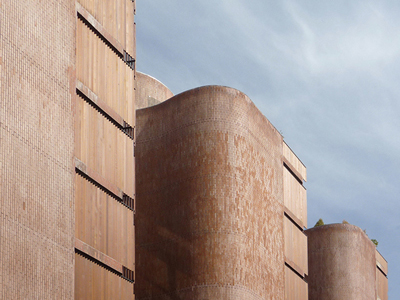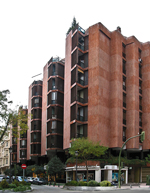You are in: Home page > Magazine Archive > Girasol: the façade as vertiginous landscape

Alessandro Isastia
Girasol: the façade as vertiginous landscape

J. A. Coderch, Girasol Apartment Building
Abstract
With the apartments of the Girasol Building, (Madrid 1964-67), J. A. Coderch brought the compositional hierarchy and the use of space in his detached houses within the traditional line of façades. The aggregative mechanism of the single units dilates the open space around which the main rooms are arranged at a dimension with landscape characteristics, made tangible also by the materials and how they are used.
In 1964 a Madrid estate agent’s commissioned the Catalan architect José Antonio Coderch de Sentmenat (1913-1984) to construct a residential building in the city’s up-market Salamanca neighbourhood. Completed in 1967 and called “Girasol”, it consists of 32 apartments ranging from 200 to 250m2 in size, shops, and underground parking facilities.1
In the monograph by C. Fochs2 Girasol can be found in the chapter on private houses. And in fact it is an agglomeration of private houses, of that kind that Coderch had been perfecting throughout his career, which he decided to use for Girasol. He insisted on inserting within the nineteenth-century perimeter block the roominess of the single house which, cannily multiplied, gave rise to the dimension of an artificial landscape.
Coderch was intolerant of the perimeter block building3, which in Madrid could exceed 20 metres in depth with narrow light wells: at Girasol these were avoided and by turning the dwellings towards the south west the best exposure to sunlight was found with incidental views of the street that gaze far beyond its modest width4. He laid out the main area on the emptiness provided by a recess, that which in a private house is the secluded area of the garden, which combines a communicating living room with loggia and a night zone, while the service rooms, stairs and lifts overlook the courtyard. A membrane accompanies the development of each single unit column, which find corporeity by lining up back to back5.
The living room is approximately 4 metres wide by 12 metres in length. This membrane delimits its long side, a continuous wall between the interior and the exterior over 20 metres long, which can be taken in with a single glance, and is even greater than the width of the road the house overlooks. The membrane curves in on itself, in the living room, generating a concavity that houses the fireplace, for the architect one of the focal centres of a house, while beyond the loggia it appears in its true vertical dimension; the horizontal, intimate compressed space of the living room/loggia thus encounters a verticality that drops away beneath the slab of the loggia and continues above; this is the dimension of the city building that Coderch turns towards the landscape, while the relationship established between the apartment and the open space recalls that of a cleft in a cliff. One can venture into this empty space in the cliff, climbing it, to measure its verticality, from the three steps of the external passage behind the blinds. In parallel, the night zone’s cantilevered outwards projection occurs both through the geometric progression of the rooms, and the three-step rise from the last room, the one onto the street, the main room.
From the inside, from the living room or the loggia, a scene of the indefinite or the dissolution, made up of the sensual delight of the brickwork and the buzz of the slats, tangible elements within the space of the loggia which dissolve as they recede: the membrane swells and twists, and on this convexity the radiant sun plays out a good part of its afternoon excursion, while the rhythm of the slats fades into the void.
The dwelling opens up to the city in the discretion of the blinds and the silence of the membranes.
On the façade, a rhythm of solid and muffled forms whose brick cladding devoid of structural pretensions is placed vertically, hanging there declaring its own shallowness by surpassing the intrados of the free floor, alternating with screens shielded by sharp elements (the vertical slats are wooden and have a triangular section). These two corporeities blend in the portion of the building projecting over the street: the soft volume empties and stiffens biting into the blinds inside the slabs. However, the blinds remain independent; they do not follow the mediating link between the two sides of the extremity, but follow the foundations of the larger sides into the void, leaving an expressive opening. The whole of this system remains suspended over an emptied, compressed floor, dotted with pillars6, pierced by the oblique emptiness of the patios, which constitute a transition between the dimension of the street and the private one of the refuge of the apartments, accessed directly from the lift. Then the base sinks into the ground, acknowledges shops on the ground floor, in fact offers two floors, with the patios of the basement level in view as a projection of the recesses above.
A glance of the corner from Calle Ortega y Gasset can be perpendicular to the oblique recesses and allows a glimpse of the building’s compositional hierarchy, which is similar to that of the private houses: the centre, the day zone, is withdrawn and from its shady recess dominates the open space in front of it. The night zone unfolds along the side of the same space until it projects over the street, contained by the membrane. One is an ordering element, immobile, suspended, bashful, taller and crowned by a heavy full strip, the other is the lateral wing, dynamic, serried and subordinate.
The Girasol finds affinity in Coderch’s long process of developing the dwelling: with the Casa Ferrer Vidal (1947), on the Majorcan coast, he finally found the chance to abandon the icon and the compact volume to chain together/shake loose the house’s spaces/volumes among the trees of the wood. With the Casa Ugalde (1951)7, in the shapes of the hills and the curvilinear stone walls that carve out the site containing the villa, linked to its radial, loosely arranged rooms. The Girasol works like the Casa Ugalde, with its membranes clad in brickwork that create the site of the apartment and its landscape. Nonetheless, its internal layout came after the process of refining the plan which culminated in the Casa Uriach (1962), whose main area is similar to that of the Girasol, and rediscovers the room, whether for night or day use, as a space and volume which, in its irreducible singularity acts as a base element of the composition. In contrast with the still volume of the day zone, the flight of the night zone becomes a rhythmic series of volumes, unfolding along a cliff8 while projecting over a Madrid street, albeit protected by a brick membrane. Which in fact has the same function as the cliff, accompanying the development of the house.
The perfection of the ground plan then became calligraphy in the outcomes of the Banco Urquijo (1967) and Las Cocheras (1968), where the centrifugal/centripetal nature of the single volumes of the rooms determines the building’s chiaroscuro mass; with no more need of further elements such as membranes, it is the single volume, repeated indefinitely in greater aggregations9, that crystallizes into an artificial landscape.
Notes
1 The whole story of the project was reported in López Peláez, 2007, 171-187.
2 Fochs, 1998, 110.
3 Soria, 1997, 84.
4 The building is called “Girasol” (sunflower), precisely because of its orientation towards the light on the proposal of the builder (López Peláez, 2007, 177-179); Rafael Moneo was unconvinced of the result, at least for the lower floors, as he wrote in an article in Arquitectura in 1967 (various authors, 1978, 101.)
5 López Peláez, 2007, 173; Similarities can be found between the Girasol and the Hotel del Mar (Palma de Mallorca, 1962), in the obliqueness of the cells and the use of vertical slats.
6 Metal Structure: 4 x 5 m..
7 Coderch wrote that he found his way in architecture with Casa Ugalde, from a letter quoted in Diez, 2003, 15.
8 See Casa Roses (1962)
9 See, among last projects, the Gran Kursaal in San Sebastian (1971).
Alessandro Isastia. PhD in Architecture, Urban Planning, Conservation of dwellings and the landscape, and lecturer in Landscape Architecture and Infrastructure at the Polytechnic of Milan.














